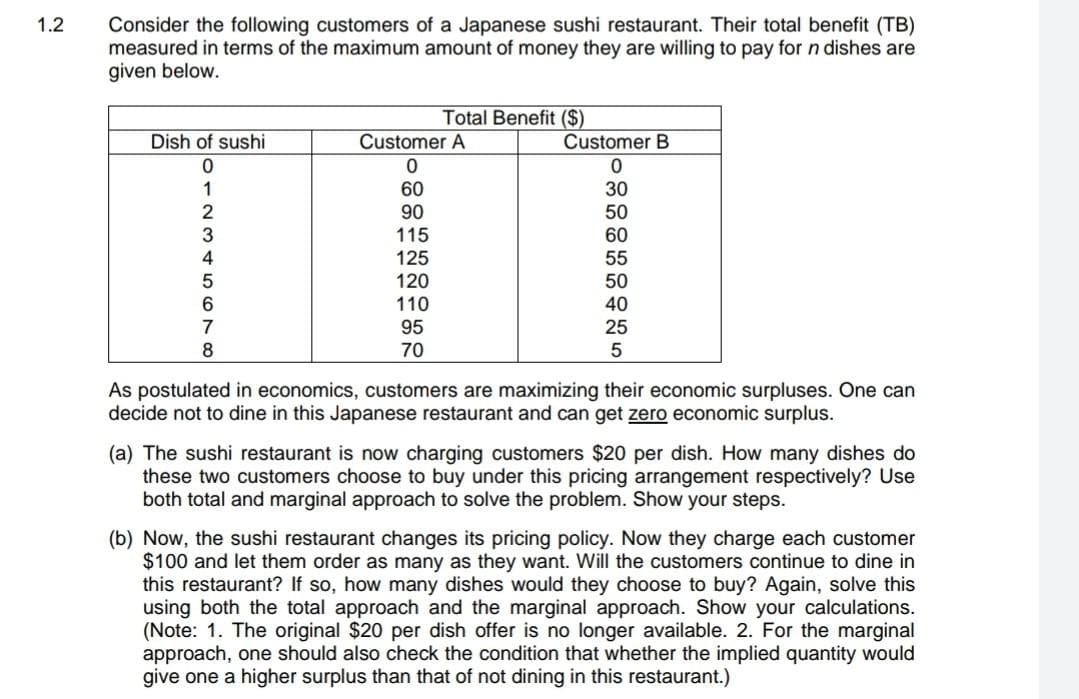Consider the following customers of a Japanese sushi restaurant. Their total benefit (TB) measured in terms of the maximum amount of money they are willing to pay for n dishes are given below. Dish of sushi 0 1 2 3 4567 8 Customer A 0 60 90 115 125 120 110 Total Benefit ($) 95 70 Customer B 0 30 50 60 55 50 40 25 5 As postulated in economics, customers are maximizing their economic surpluses. One can decide not to dine in this Japanese restaurant and can get zero economic surplus. (a) The sushi restaurant is now charging customers $20 per dish. How many dishes do these two customers choose to buy under this pricing arrangement respectively? Use both total and marginal approach to solve the problem. Show your steps. (b) Now, the sushi restaurant changes its pricing policy. Now they charge each customer $100 and let them order as many as they want. Will the customers continue to dine in this restaurant? If so, how many dishes would they choose to buy? Again, solve this using both the total approach and the marginal approach. Show your calculations. (Note: 1. The original $20 per dish offer is no longer available. 2. For the marginal approach, one should also check the condition that whether the implied quantity would give one a higher surplus than that of not dining in this restaurant.)
Consider the following customers of a Japanese sushi restaurant. Their total benefit (TB) measured in terms of the maximum amount of money they are willing to pay for n dishes are given below. Dish of sushi 0 1 2 3 4567 8 Customer A 0 60 90 115 125 120 110 Total Benefit ($) 95 70 Customer B 0 30 50 60 55 50 40 25 5 As postulated in economics, customers are maximizing their economic surpluses. One can decide not to dine in this Japanese restaurant and can get zero economic surplus. (a) The sushi restaurant is now charging customers $20 per dish. How many dishes do these two customers choose to buy under this pricing arrangement respectively? Use both total and marginal approach to solve the problem. Show your steps. (b) Now, the sushi restaurant changes its pricing policy. Now they charge each customer $100 and let them order as many as they want. Will the customers continue to dine in this restaurant? If so, how many dishes would they choose to buy? Again, solve this using both the total approach and the marginal approach. Show your calculations. (Note: 1. The original $20 per dish offer is no longer available. 2. For the marginal approach, one should also check the condition that whether the implied quantity would give one a higher surplus than that of not dining in this restaurant.)
Principles of Economics 2e
2nd Edition
ISBN:9781947172364
Author:Steven A. Greenlaw; David Shapiro
Publisher:Steven A. Greenlaw; David Shapiro
Chapter6: Consumer Choices
Section: Chapter Questions
Problem 1SCQ: Jeremy is deeply in love with Jasmine. Jasmine lives where cell phone coverage is poor, so he can...
Related questions
Question

Transcribed Image Text:1.2
Consider the following customers of a Japanese sushi restaurant. Their total benefit (TB)
measured in terms of the maximum amount of money they are willing to pay for n dishes are
given below.
Dish of sushi
0
1
2
3
4
5
6
7
8
Customer A
0
60
90
Total Benefit ($)
115
125
120
110
95
70
Customer B
0
30
50
60
55
50
40
25
5
As postulated in economics, customers are maximizing their economic surpluses. One can
decide not to dine in this Japanese restaurant and can get zero economic surplus.
(a) The sushi restaurant is now charging customers $20 per dish. How many dishes do
these two customers choose to buy under this pricing arrangement respectively? Use
both total and marginal approach to solve the problem. Show your steps.
(b) Now, the sushi restaurant changes its pricing policy. Now they charge each customer
$100 and let them order as many as they want. Will the customers continue to dine in
this restaurant? If so, how many dishes would they choose to buy? Again, solve this
using both the total approach and the marginal approach. Show your calculations.
(Note: 1. The original $20 per dish offer is no longer available. 2. For the marginal
approach, one should also check the condition that whether the implied quantity would
give one a higher surplus than that of not dining in this restaurant.)
Expert Solution
This question has been solved!
Explore an expertly crafted, step-by-step solution for a thorough understanding of key concepts.
Step by step
Solved in 5 steps

Knowledge Booster
Learn more about
Need a deep-dive on the concept behind this application? Look no further. Learn more about this topic, economics and related others by exploring similar questions and additional content below.Recommended textbooks for you

Principles of Economics 2e
Economics
ISBN:
9781947172364
Author:
Steven A. Greenlaw; David Shapiro
Publisher:
OpenStax

Principles of Microeconomics
Economics
ISBN:
9781305156050
Author:
N. Gregory Mankiw
Publisher:
Cengage Learning


Principles of Economics 2e
Economics
ISBN:
9781947172364
Author:
Steven A. Greenlaw; David Shapiro
Publisher:
OpenStax

Principles of Microeconomics
Economics
ISBN:
9781305156050
Author:
N. Gregory Mankiw
Publisher:
Cengage Learning


Principles of Economics, 7th Edition (MindTap Cou…
Economics
ISBN:
9781285165875
Author:
N. Gregory Mankiw
Publisher:
Cengage Learning

Principles of Economics (MindTap Course List)
Economics
ISBN:
9781305585126
Author:
N. Gregory Mankiw
Publisher:
Cengage Learning

Principles of Microeconomics (MindTap Course List)
Economics
ISBN:
9781305971493
Author:
N. Gregory Mankiw
Publisher:
Cengage Learning